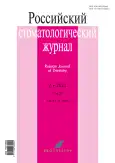Orthodontic neuroorthopedic pathology in children and adolescents with pain dysfunction syndrome of the temporomandibular joint
- Authors: Silantyeva E.N.1,2, Anokhina A.V.1, Hafizov R.G.1
-
Affiliations:
- Kazan Federal University
- Kazan state medical Academy
- Issue: Vol 27, No 2 (2023)
- Pages: 87-95
- Section: Clinical Investigation
- URL: https://journals.rcsi.science/1728-2802/article/view/131228
- DOI: https://doi.org/10.17816/dent122021
- ID: 131228
Cite item
Abstract
BACKGROUND: The number of children and adolescents with temporomandibular joint pain dysfunction syndrome (TMJ SPD) is increasing annually. One of the causes of this disease is dental pathology, particularly dental anomalies.
AIM: To study the prevalence of TMJ SPD in children and adolescents and the role of orthodontic and neuroorthopedic pathology in its occurrence.
MATERIAL AND METHODS: A survey of 622 students from state educational institutions was carried out. The students were divided into two age groups according to the main period of dental formation and the age periodization scheme of human ontogenesis. The students were divided into two groups with and without orthodontic pathology, and four subgroups: subgroup 1 was children without dentofacial abnormalities (n=92); subgroup 2 was children with dentofacial anomalies (n=66); subgroup 3 was teenagers without dentofacial anomalies (n=313), and subgroup 4 was teenagers with dentofacial anomalies (n=151).
RESULTS: An increase in the prevalence of TMJ SPD was found in adolescents (weak reliable relationship, r=0.10, p <0.05). In the two age groups, correlation analysis revealed a weak reliable relationship between dental anomalies and TMJ SPD (r=0.212 for children and r=0.161 for adolescents, p <0.01); as well as a weak significant association between distal bite (r=0.131, p <0.010), and an excessively deep vertical bite with TMJ SPD (r=0.152, p <0.010) in adolescents. A significant association was detected between scoliosis and TMJ SPD (r=0.340, p <0.010) in both age groups.
CONCLUSION: An increase in the prevalence of TMJ SPD was found in adolescents. Dental anomalies that occur during adolescence may be a cause of TMJ SPD; however, the main role is played by cervical vertebral dystrophic syndrome, scoliosis, and (or) postural disorders. In all cases, TMJ SPD was diagnosed with signs of cervical vertebral dystrophic syndrome, scoliosis, and (or) postural disorders, the clinical manifestations of which depended on the age of the student. Thus, it is necessary to conduct a comprehensive multidisciplinary examination on all patients with TMJ SPD and include dentists, neurologists, pediatricians, and, if necessary, orthodontists.
Full Text
##article.viewOnOriginalSite##About the authors
Elena N. Silantyeva
Kazan Federal University; Kazan state medical Academy
Author for correspondence.
Email: elenasilantjeva@mail.ru
ORCID iD: 0000-0002-2701-6374
SPIN-code: 7501-3430
MD, Cand. Sci. (Med.), Assistant Professor
Russian Federation, Kazan; KazanAntonina V. Anokhina
Kazan Federal University
Email: a_anokhina@mail.ru
ORCID iD: 0000-0001-5134-8590
SPIN-code: 3009-9993
MD, Dr. Sci. (Med.), Professor
Russian Federation, KazanRais G. Hafizov
Kazan Federal University
Email: implantstom@bk.ru
ORCID iD: 0000-0001-6578-6743
SPIN-code: 4041-9445
MD, Dr. Sci. (Med.), Professor
Russian Federation, KazanReferences
- Ibragimova RS, Bokaeva AM, Fedorov DE, et al. Prevalence of functional disorders of the temporomandibular joint in children, adolescents and young people. Bulletin of the Kazakh National Medical University. 2013;(1):116–120 (in Russ).
- Ponomarev AV. Diagnostika, ocenka jeffektivnosti lecheniya i prognozirovanie disfunktsii visochno-nizhnechelyustnogo sustava [dissertation]. Samara; 2018 [cited 2023 Jan 22]. Available from: https://www.dissercat.com/content/diagnostika-otsenka-effektivnosti-lecheniya-i-prognozirovanie-disfunktsii-visochno-nizhneche. (In Russ).
- Andriyanov DA. Kliniko-rentgenologicheskoe obosnovanie funkcional’nogo sostojanija visochno-nizhnechelyustnogo sustava u detej s distal’noi okklyuziei [dissertation]. Samara; 2023 [cited 2023 Jan 22]. Available from: https://www.dissercat.com/content/kliniko-rentgenologicheskoe-obosnovanie-funktsionalnogo-sostoyaniya-visochno-nizhnechelyustn. (In Russ).
- Ishmurzin P.V. Disfunktsiya visochno-nizhnecheljustnogo sustava, associirovannaya s zubocheyustnymi anomaliyami, u lits molodogo vozrasta: printsipy i metody ortodonticheskoi korrektsii [dissertation]. Perm; 2013 [cited 2023 Jan 22]. Available from: https://www.dissercat.com/content/disfunktsiya-visochno-nizhnechelyustnogo-sustava-assotsiirovannaya-s-zubochelyustnymi-anomal. (In Russ).
- Hachaturjan EE. Kompleksnyi podkhod k diagnostike i terapii bolevoi disfunktsii visochno-nizhnechelyustnogo sustava [dissertation]. Moscow; 2013 [cited 2023 Jan 22]. Available from: https://www.dissercat.com/content/autoref-kompleksnyi-podkhod-k-diagnostike-i-terapii-bolevoi-disfunktsii-visochno-nizhnechelyustnogo-.pdf. (In Russ).
- Lopushanskaya TA, Petrosyan LB. Clinical features characteristic of persons with impaired functioning of the temporomandibular joint. Bulletin of the Novgorod State University. 2017;(3):91–92. (In Russ).
- Oreshaka OV, Dementieva EA, Ganisik AV, Sharov AM. Epidemiology of diseases of the temporomandibular joint. Clinical dentistry. 2019;(4):97–99. (In Russ). doi: 10.37988/1811-153X_2019_4_97
- Nesterov AM, Tsymbalov EE, Nikulina MA. Evaluation of the longitudinal arch of the foot in patients with temporomandibular joint dysfunction. Clinical dentistry (Russia). 2022;25(2):100–104. (In Russ). doi: 10.37988/1811-153X_2022_2_100
- Nikulina MA. Digital occlusion analysis in an interdisciplinary approach to temporomandibular joint dysfunction. Clinical dentistry (Russia). 2022;25(3):48–53. (In Russ). doi: 10.37988/1811-153X_2022_3_48
- Kupriyanova ON, Puzin MN. Syndrome of pain dysfunction of the temporomandibular joint in patients with connective tissue dysplasia. Russian Journal of Dentistry. 2007;(2):34–36. (In Russ).
- Nesterov AM, Tsymbalov EE, Nikulina MA, Kancepolsky AN. Osteopathic correction as part of the complex treatment of temporomandibular joint dysfunction. Russian Osteopathic Journal. 2022;4(59):103–115. (In Russ). doi: 10.32885/2220-0975-2022-4-103-115
- Redinova TL, Redinov IS, Chikurova NV. Diseases of the musculoskeletal complex of the temporomandibular joint: frequency of occurrence, clinic, etiopathogenetic factors. Russian Journal of Dentistry. 2021;25(2):185–192. (In Russ). doi: 10.17816/1728-2802-2021-25-2-185-192
- Khaibullina RR, Gerasimova LP, Kuznetsova NS. Diagnosis and treatment of patients with chronic generalized periodontitis and musculoskeletal dysfunction of the temporomandibular joint with pain syndrome. Russian Journal of Dentistry. 2017;19(4):200–203. (In Russ). doi: 10.18821/1728-2802-2017-21-4-200-203
- Silantieva EN, Khitrov VYu. Myofascial pain dysfunctional syndrome of the maxillofacial region in children and adolescents. Pediatric dentistry and dental prophylaxis. 2004;(3-4):66–69. (In Russ).
- Silantieva EN, Khitrov VYu. The influence of dental anomalies on the occurrence of myofascial pain dysfunctional syndrome of the maxillofacial region in children and teenagers. Pediatric dentistry and dental prophylaxis. 2005;(1-2):75–78. (In Russ).
- Silantieva EN, Anokhina AV, Berezina NV. Syndrome of pain dysfunction of the temporomandibular joint in adolescence. Pediatric dentistry and dental prophylaxis. 2014;2:18–22. (In Russ).
- Slesarev OV. Kliniko-diagnosticheskoe obosnovanie metodologii i printsipov mezhdisciplinarnogo podhoda v lechenii bol’nykh s visochno-nizhnechelyustnymi rasstroistvami [dissertation]. Samara; 2020 [cited 2023 Jan 25]. Available from: https://www.dissercat.com/content/kliniko-diagnosticheskoe-obosnovanie-metodologii-i-printsipov-mezhdistsiplinarnogo-podkhoda/read. (In Russ).
Supplementary files








